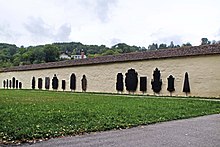Königsbronn monastery
| Cistercian Abbey of Königsbronn | |
|---|---|
| location | Germany Baden-Wuerttemberg |
| Coordinates: | 48 ° 44 '34 " N , 10 ° 6' 49" E |
| Serial number according to Janauschek |
696 |
| Patronage | Maria |
| founding year | 1302 |
| Year of dissolution / annulment |
1553 |
| Mother monastery | Salem Monastery |
|
Daughter monasteries |
no |
Königsbronn Monastery (ad fontem regis = "at the king's source") is a former Cistercian monastery in Baden-Württemberg .
location
The remains of the monastery are in the Springen district of the municipality of Königsbronn in the Heidenheim district near the Brenztopf .
history

In 1303, founded King Albert I a Cistercian monastery (one of the last in medieval Germany, later only the conversion of the Benedictine Stolpe and the collection of Gotteszell to the Abbey and various priories, especially in the Lower Rhine), the monks of Salem Abbey settled has been. The monastery is thus part of the filiation of the primary abbey of Morimond . The monastery buildings were erected from 1310 to 1325 with stones from Herwartstein Castle. The monastery had a courtyard in Reutlingen . During the dispute between Ludwig the Bavarian and the Pope, it took the side of the Pope. In 1346 the monastery was attacked by the troops of the later emperor Charles IV . The Helfensteiner received the area again in 1365 as a fiefdom from Emperor Charles IV. After the emperor's death in 1378, ownership changed and the bailiwick changed several times. Württemberg , which Heidenheim an der Brenz had acquired from the Helfensteiners, raised claims to the area, while the abbot considered the monastery to be imperial . In 1539 the monastery was to be reformed . However, the monks refused to accept the new faith. In the aftermath of the Schmalkaldic War , Königsbronn was burned down and completely razed to the ground in 1552 by the troops of the Margrave of Brandenburg-Kulmbach, Albrecht Alcibiades , in the Second Margrave War . The "very splendid" old monastery church was also destroyed.
The monastery was abolished by Duke Ulrich and abandoned by the Catholic monks. After the Peace of Augsburg in 1555, the monastery was converted into a Protestant monastery school by Duke Christoph in 1556 under the direction of a Protestant abbot, which only existed until 1595. The Edict of Restitution of 1629 meant that Königsbronn should become Catholic again, but this met with resistance from the population. After the Thirty Years' War in 1648, Königsbronn finally became part of Württemberg and Protestant; from 1648 to 1806 it was again the seat of a Protestant abbot.
Plant and buildings
Only the western wall of the medieval buildings has been preserved. The foundation walls of the monastery church now serve as a garden wall. A museum has been set up in the gatehouse. The former prelature (parish and forester's house) from 1757 and the Oberamtei with the prince's hall from around 1700 have also been preserved. Today's parish church in Königsbronn has been called the former lay church and is probably on its place, but it originates only from the year 1565 and was rebuilt inside in 1710 and received a massive west tower in 1745.
literature
- Peter Pfister: Guide to all Cistercian monasteries in German-speaking countries , Strasbourg: Éditions du Signe, 2nd edition 1998, p. 75, ISBN 2-87718-596-6 .
- Ambrosius Schneider: Lexical overview of the male monasteries of the Cistercians in the German language and cultural area , in: Schneider, Wienand, Bickel, Coester, Die Cisterzienser, 3rd edition 1986, Wienand Verlag Köln, p. 668, ISBN 3-87909-132- 3 .
- Georg Dehio: Handbuch der Deutschen Kunstdenkmäler , Volume Baden-Württemberg I, Munich and Berlin 1963: Deutscher Kunstverlag, p. 434, ISBN 3-422-03024-7 .
Web links
- Cistercian Abbey Königsbronn in the database of monasteries in Baden-Württemberg of the Baden-Württemberg State Archives
- Germania Sacra monastery database
- cistercium.info
- Evangelical Cistercian heirs
- Klaus Graf : Exceptionally poorly researched: the Cistercian monastery Königsbronn near Heidenheim with numerous literature and online references

